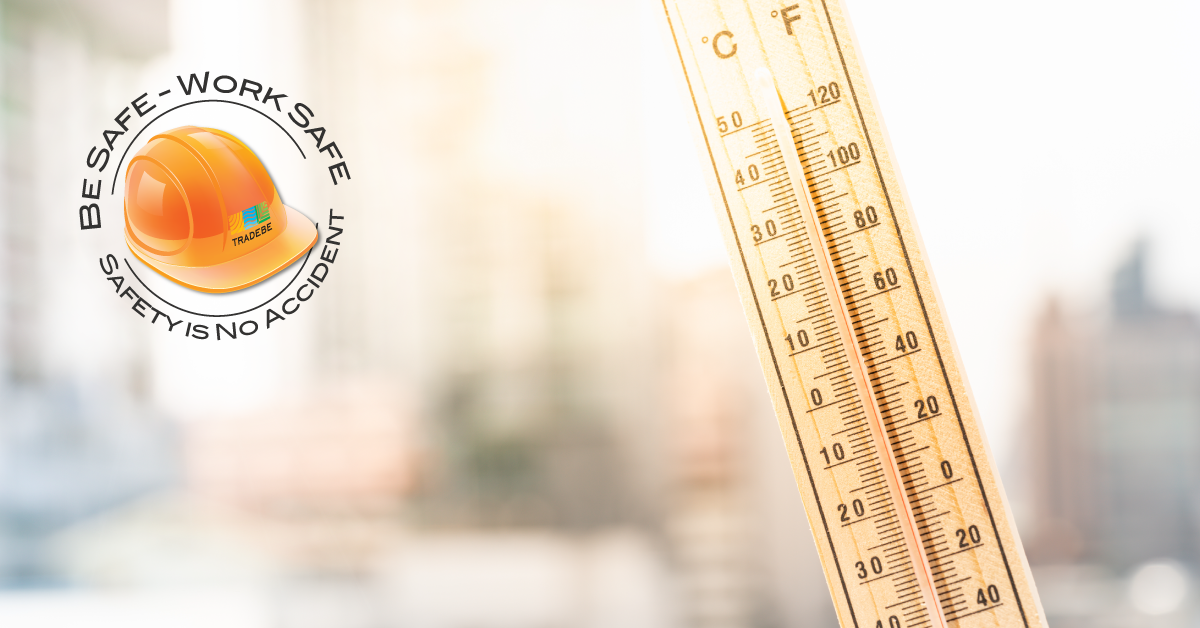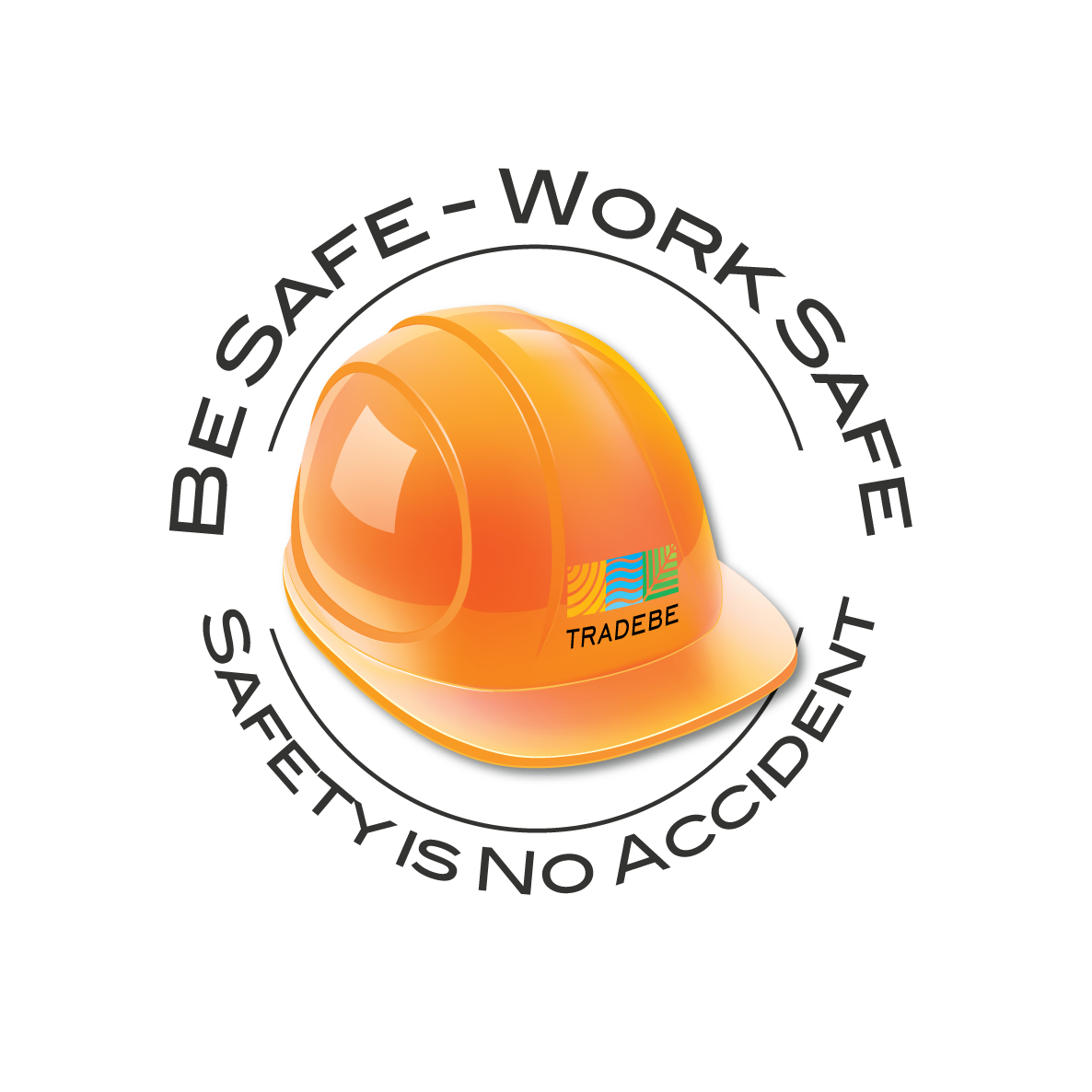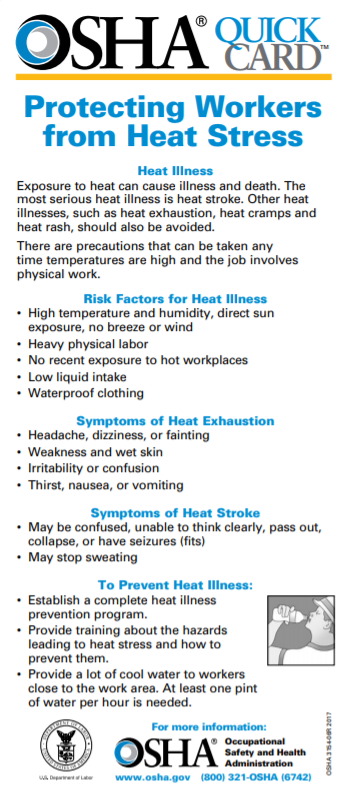
Category
Health & SafetyCreation date
The Risk of Heat Stress is on the Rise as Summer Begins and Temperatures Climb.
Keep Your Team Safe - Learn How to Avoid Heat Stress! Read more…
Avoiding Heat Stress is a High Priority for Managers and Workers in Outdoor Work Environments.
Our bodies naturally maintain a temperature between 96°F and 99°F. Sweating cools our bodies down, but if you work in a hot environment this might not be enough.
If your body heats up faster than it can cool itself down, you experience heat stress. This can lead to serious heat disorders and potential injury.
Workers are exposed by
three main causes of Heat Stress:
The Environment
- Radiant heat from direct or indirect sunlight (reflection from pavement or kilns)
- Air temperature hotter than skin temperature (warms a worker up)
- High humidity (makes it harder for a worker to cool down)
The work
- The more active you are, the more heat you will produce
The worker
- Conditioning, (regular work in hot environments makes workers less prone to heat stress)
- Poor health, including obesity, advanced age, and medical conditions (the body responds poorly to overheating)
- Not staying hydrated
- Excess clothing or inappropriate personal protective equipment (they trap heat and prevent cooling)
The Dangers to Workers: As a worker's body heats up it loses fluids and salt through sweat. As workers dehydrate they are less able to cool themselves down.
So always stay hydrated especially in hot working conditions!
Warning Signs of Heat Stress
Workers, especially in a Hot Environment, should be aware of these three warning signs:
- Excessive sweating
- Dizziness
- Nausea
Heat Disorders
If heat stress is not recognized and treated early, it can lead to heat disorders, which have serious effects on the body. These include:
Heat cramps
- Painful muscle cramps
- Can lead to heat exhaustion if left untreated
Heat exhaustion
- Shallow breathing
- Increased heart rate
- Weak, rapid pulse
- Cool, pale, clammy skin
- Sweating
- Weakness, fatigue, dizziness
- Headache and nausea
- Fainting
- Muscle cramps
- Can lead to heat stroke if left untreated
Heat stroke
- Hot, dry, flushed skin
- No longer sweating
- Agitation and confusion
- Decreased level of consciousness and awareness
- Headache
- Nausea and vomiting
- Seizures
- Increase in breathing rate
- Irregular pulse
- Shock
- Cardiac arrest
How to Protect Workers: The most effective way to reduce the risk of Heat Stress is to eliminate the source of exposure. If that's not possible, there are other risk controls to use.
Heat Stress Risk Controls
When choosing risk controls, start by asking yourself the questions in the following steps, which are listed in order of effectiveness.
1. Elimination or substitution
Eliminating the hazard by substituting a safer process or material, where possible, is the most effective control. A question to consider:
- Can the job be done in a cooler environment?
2. Engineering controls
Making physical modifications to facilities, equipment and processes can reduce exposure. Some questions to consider:
- Can ventilation be improved?
- Can hot surfaces be insulated or covered to reduce radiant heat?
- Can shields and barriers be installed to protect workers from heat?
- Can humidity be reduced?
3. Administrative controls
Changing work practices and work policies, awareness tools, and training can limit the risk of heat stress. Some questions to consider:
- Can warning signs be posted in the work area?
- Can cool-down rooms be provided?
- Can workers be acclimated to heat?
- Can water be provided?
4. Personal protective equipment
This is the least effective control. It must always be used in addition to at least one other control. Some questions to consider:
- Do workers have heat-reflective clothing or water-cooled suits?
- Has personal protective equipment been tested to make sure it is working properly?
Need help with your Safety and Compliance Training Programs?

Contact us now and let us put our expertise to work for you!
“Be Safe - Work Safe. Safety is No Accident!”
Danny Messercola, Heath and Safety Coordinator ,Tradebe USA
#SafetyBlog #HealthandSafety #HealthandSafetyPlan #AvoidingHeatStress #ToolboxTalks #BeSafeWorkSafe #SafetyisNoAccident
Resources:
https://www.osha.gov/Publications/osha3154.pdf
https://www.cdc.gov/niosh/topics/heatstress/default.html
Related articles and information:
- Tradebe blog article "Defensive Driving"
- Tradebe blog article "Creative Tools for Training Retention"
- Tradebe blog article "Understanding Proper PPE"
Subscribe to Tradebe Safety Blog, news and more...
__________________________________________
At Tradebe, our priorities are safety and the protection of people and the environment. Safety is a common “water cooler” topic here at Tradebe where a culture of Safety is Top Priority. If Safety is important to your business, catch the latest buzz: Subscribe Now…

